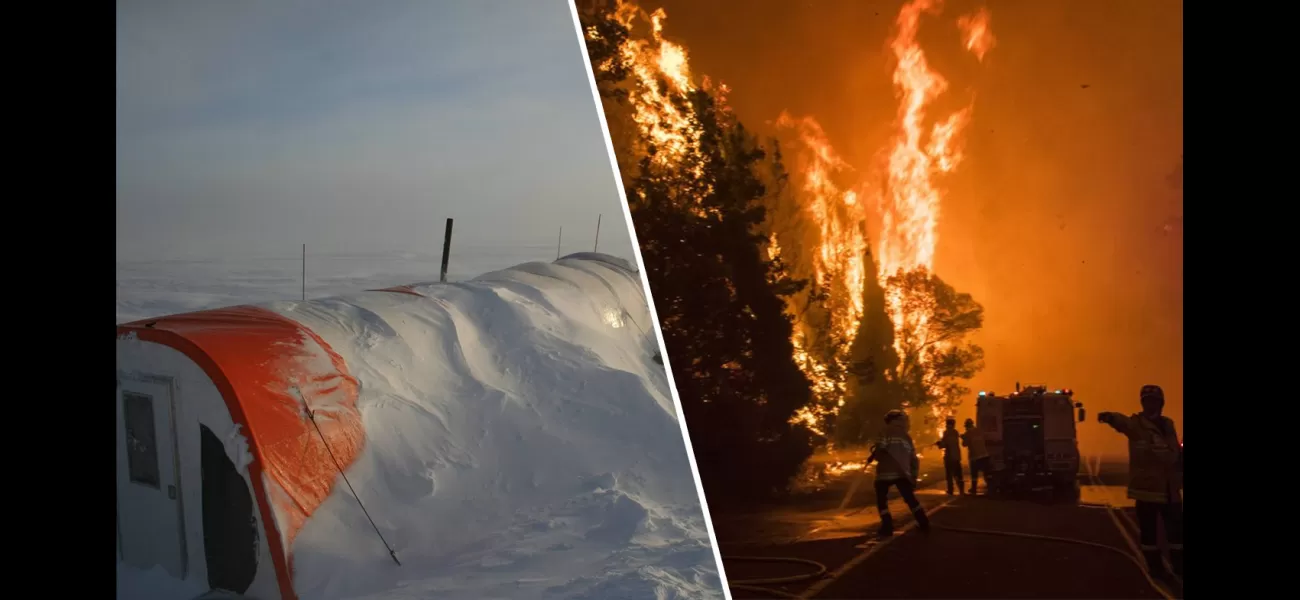Warning bell rings for Australia's fire risk hidden in the ice.
The Black Summer fires were unlike any other in terms of size and intensity, but new evidence suggests a different narrative.
June 14th 2024.

A recent study has revealed some concerning information about Australia's weather patterns, stretching back 2000 years. It seems that the country has experienced bushfire seasons even more devastating than the catastrophic Black Summer fires, and there is a possibility that they will occur again in the future.
The Black Summer fires of 2019/2020 were truly devastating, claiming the lives of 33 individuals and destroying over 3000 homes. The damage caused to the land was also immense, with more than 20 million hectares of land being scorched. These fires were unprecedented in terms of their scale and intensity, at least according to records dating back to 1950.
But now, a team of climate scientists has turned their attention to Antarctic sea ice in order to gain a deeper understanding of Australia's weather patterns. What they found was that there is a strong connection between the two continents, known as a "weather bridge". Changes in sea salt concentration, preserved in the ice core record, can indicate extreme bushfire weather in Australia. This suggests that the size of weather systems impacting Australia is so large that it also affects Antarctic weather at the same time.
The data collected from the ice core also revealed that there have been at least seven instances over the past 2000 years where bushfire weather in south-east Australia was as severe, if not worse, than during the Black Summer. This is a concerning finding, as it shows that natural climate variability can produce even more severe bushfire weather than what we experienced in 2019/2020.
Lead author of the study, Dr Danielle Udy, highlighted the importance of this information. She stated that while we are aware of the devastation caused by the Black Summer fires, we must also consider that natural climate variability can lead to even worse bushfire weather. On top of that, the effects of climate change are only adding to the intensity and frequency of these extreme weather events.
The study also serves as a warning for the future. The ice core data shows that we must prepare for bushfire seasons that could be even worse than the Black Summer. While the 2019/2020 fires were caused by a combination of factors, including drought and natural climate variability, the impact of climate change will only lead to more frequent and severe weather extremes in the years to come.
Associate Professor Anthony Kiem from the University of Newcastle emphasized the need to consider the full range of plausible natural variability when estimating and planning for Australia's bushfire risk. This includes taking into account the projected impacts of climate change. It is clear that we cannot afford to ignore the warning signals hidden in the ice. We must act now to mitigate the risks and protect our communities from the devastating effects of extreme bushfire weather.
The Black Summer fires of 2019/2020 were truly devastating, claiming the lives of 33 individuals and destroying over 3000 homes. The damage caused to the land was also immense, with more than 20 million hectares of land being scorched. These fires were unprecedented in terms of their scale and intensity, at least according to records dating back to 1950.
But now, a team of climate scientists has turned their attention to Antarctic sea ice in order to gain a deeper understanding of Australia's weather patterns. What they found was that there is a strong connection between the two continents, known as a "weather bridge". Changes in sea salt concentration, preserved in the ice core record, can indicate extreme bushfire weather in Australia. This suggests that the size of weather systems impacting Australia is so large that it also affects Antarctic weather at the same time.
The data collected from the ice core also revealed that there have been at least seven instances over the past 2000 years where bushfire weather in south-east Australia was as severe, if not worse, than during the Black Summer. This is a concerning finding, as it shows that natural climate variability can produce even more severe bushfire weather than what we experienced in 2019/2020.
Lead author of the study, Dr Danielle Udy, highlighted the importance of this information. She stated that while we are aware of the devastation caused by the Black Summer fires, we must also consider that natural climate variability can lead to even worse bushfire weather. On top of that, the effects of climate change are only adding to the intensity and frequency of these extreme weather events.
The study also serves as a warning for the future. The ice core data shows that we must prepare for bushfire seasons that could be even worse than the Black Summer. While the 2019/2020 fires were caused by a combination of factors, including drought and natural climate variability, the impact of climate change will only lead to more frequent and severe weather extremes in the years to come.
Associate Professor Anthony Kiem from the University of Newcastle emphasized the need to consider the full range of plausible natural variability when estimating and planning for Australia's bushfire risk. This includes taking into account the projected impacts of climate change. It is clear that we cannot afford to ignore the warning signals hidden in the ice. We must act now to mitigate the risks and protect our communities from the devastating effects of extreme bushfire weather.
[This article has been trending online recently and has been generated with AI. Your feed is customized.]
[Generative AI is experimental.]
0
0
Submit Comment





